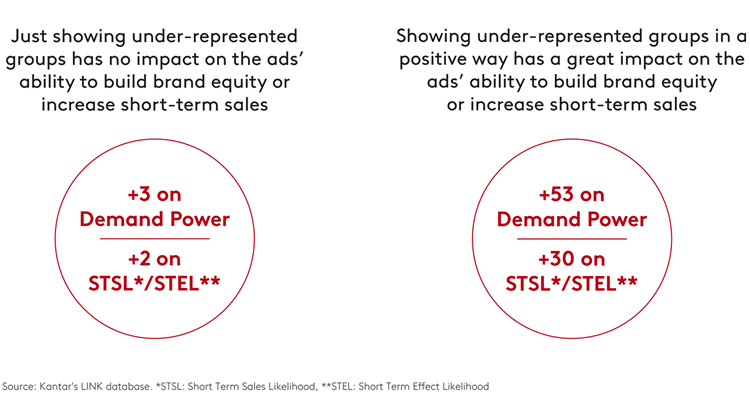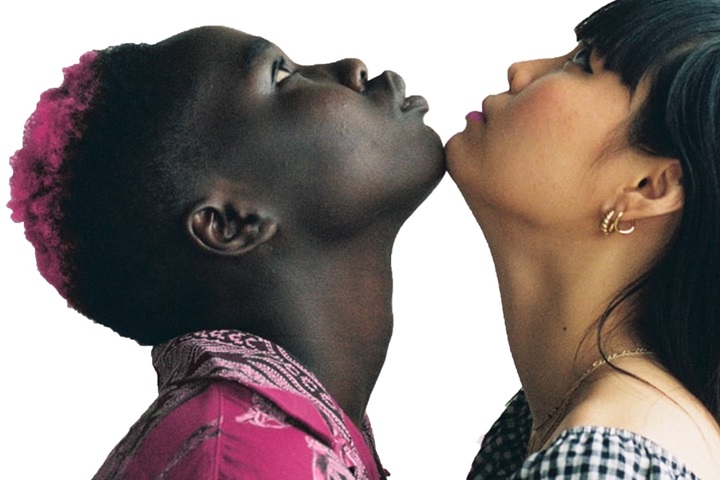The advancements and the alarm bells
According to Kantar’s Brand Inclusion Index, 7 in 10 people think that brands are making an effort to be more inclusive. Specifically, gender portrayal in advertising has witnessed notable improvements over the past five years. In 2019, Kantar and the Unstereotype Alliance, an industry-led coalition convened by UN Women to eradicate harmful stereotypes in advertising content, co-created a Gender Unstereotype Metric (GUM) to help advertisers measure how well they portray people in advertising. In the five years since, portrayal of both women and men has made significant progress, as we see big increases on the measure. This is a powerful signal that the effort made by the industry is beginning to bring change. However, it is also worth noting, that at the raw score level, consumers rate women’s portrayal stronger than that of men, which further proves that brands have to continue to pay attention to how they portray both.
Progress on positive portrayals

The improvements in gender portrayal have been driven by advancements on how different aspects of women and men are represented in advertising. The Kantar LINK database shows that women now receive increased screen time and are granted more prominent roles when featured alongside men. This shift is also accompanied by the rising inclusion of women's speaking lines at the expense of sole male narration.
Despite the progress made, it's crucial for brands to recognise that the journey towards equitable and inclusive advertising is ongoing and the commitment needs to be sustained. When reviewing the data on inclusive representation in advertising, we also hear some alarm bells. For example, we see a decrease in portraying both men and women in non-traditional roles as well as a decrease in the number of ads that portray diverse body types or grant people from ethnically underrepresented group a leading role. Furthermore, certain groups remain grossly underrepresented in advertising globally – LGBTQI+, people living with disabilities, as well as older demographics. Underrepresentation ties to people’s lived experiences of discrimination and hence the advertising and marketing industry must continue working to close inclusion gaps. According to the Kantar Brand Inclusion Index, 65% of those that aren’t well represented in advertising have experienced discrimination in the last year, which is ten percentage points higher than people who are regularly represented in advertising.
Inclusive advertising = better advertising
While increasing presence of underrepresented groups via casting is important, more needs to be done for advertising portrayal to be truly inclusive and make a positive impact on society. Getting inclusive portrayal right is also important commercially, as our analysis shows. What matters for creative effectiveness is how people are portrayed, what roles they are given and whether their lived experience and perspective are being reflected. According to Kantar’s LINK database, including a character from an under-represented group in an ad does not have a significant impact on effectiveness. However, if that character is portrayed positively, then the ad’s potential to drive long-term equity for the brand as well as drive sales in the short-term increases massively.
Inclusive advertising has a positive impact on advertising ROI

One way that brands can improve people's portrayal is to expand not only who is visible but recognise that people hold multiple intersecting identities (such as, gender, race, sexuality, age) and present a broader spectrum of life experiences. In an Australian ad aimed at communicating its audio eraser feature, Google Pixel chose to feature a lesbian couple buying a new home and announcing that a baby is on the way and did so in an authentic way that was incidental to the story rather than driving the plot. This grounding of functional messaging in real-life experiences is one way to unstereotype advertising content.
Google Pixel’s ad ‘Audio Magic Eraser’, Australia
Another creative that brings personal hopes and dreams to life is Amazon’s christmas ad in the UK, aptly named ‘Joy Ride’. It takes viewers on an emotional ride, featuring three older women sledging together downhill. It scored in the Top 4% on representing a progressive view of society. Together, these two examples showcase women’s perspectives in a multidimensional manner.
Amazon’s ad ‘Joy Ride’, UK
CLIENT QUOTE
"Our choice to have three lead women, not only celebrated enduring friendships, but provided the opportunity to give representation to an age of woman we don’t always see in advertising. Their bond, camaraderie, and infectious joie de vivre gave the piece a particular joyousness that I think helped us stand out. It’s a story that’s instinctively true, but not often told. It was particularly important to us to give these wonderful women the chance to celebrate the different facets of themselves and how they express joy, regardless of their age. They don’t hold back! Annie O’Donnell, one of actors in the film said it best “At our age, it’s not uncommon to be typecast. And, while I will happily play the role of someone’s sweet grandmother, it is always exciting to be able to show a different side. An opportunity to shake off preconceptions and show we are not just ‘young at heart’ but still throwing ourselves into life.”
Alexa Caldecott, EU brand strategy lead at Amazon
The way forward
According to Kantar’s Global Monitor, 79% of consumers’ purchase intent is influenced by a brand’s involvement in social issues to some degree. Thus, the need for more inclusive advertising is both a social and commercial imperative. To help advertisers understand whether their creative is portraying people inclusively, the Unstereotype Alliance adopted Kantar’s Progressive Unstereotype Metric (PUM) last year. The metric captures whether an ad captures a progressive view of society. Initial analysis reveals that progressive portrayal (PUM) is not quite yet at the levels of positive people portrayal (GUM). Furthermore, very few ads are progressive without also portraying people positively, which shows that an intersectional approach that recognises the multiple identities people hold is key to making advertising more inclusive.
The link between progressive and positive gender portrayal also shows how key it is to keep up the push to eradicate gender stereotypes in advertising and showcase more positive portrayals of women as well as men so that this isn't forgotten about in the necessary drive to represent other areas of diversity more fairly.





